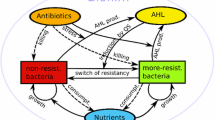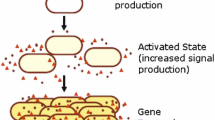Abstract
In this paper, we study quorum sensing in Pseudomonas aeruginosa biofilms. Quorum sensing is a process where bacteria monitor their population density through the release of extra-cellular signalling molecules. The presence of these molecules affects gene modulation leading to changes in behaviour such as the release of virulence factors. Here, we use numerical methods to approximate a 2-D model of quorum sensing. It is observed that the shape of the biofilm can have a profound effect on the onset of quorum sensing. This has serious repercussions for experimental observations since biofilms of the same biomass but different shapes can produce quite different results.
Similar content being viewed by others
References
Alpkvist, E., Klapper, I., 2007. A multidimensional multispecies continuum model for heterogenous biofilm development. Bull. Math. Biol. 69, 765–789.
Belytschko, T., Black, T., 1999. Elastic crack growth in finite element with minimal remeshing. Int. J. Numer. Methods Eng. 45, 601–620.
Chessa, J., Smolinski, P., Belytschko, T., 2002. The extended finite element method (xfem) for solidification problems. Int. J. Numer. Methods Eng. 53, 1959–1977.
Chopp, D.L., Kirisits, M.J., Moran, B., Parsek, M.R., 2003. The dependence of quorum sensing on the depth of a growing biofilm. Bull. Math. Biol. 65, 1053–1079.
Daux, C., Moës, N., Dolbow, J., Sukumar, N., Belytschko, T., 2000. Arbitrary branched and intersecting cracks with the extended finite element method. Int. J. Numer. Methods Eng. 48, 1741–1760.
Dockery, J., Klapper, I., 2002. Finger formation in biofilm layers. SIAM J. Appl. Math. 62, 853–869.
Dolbow, J., Moës, N., Belytschko, T., 2000a. Modeling fracture in Mindlin–Reissner plates with the extended finite element method. Int. J. Numer. Methods Eng. 37, 7161–7183.
Dolbow, J.E., Moës, N., Belytschko, T., 2000b. Discontinuous enrichment in finite elements with a partition of unity method. Finite Elem. Anal. Des. 36, 235–260.
Dolbow, J.E., Moës, N., Belytschko, T., 2001. An extended finite element method for modeling crack growth with frictional contact. Comput. Meth. Appl. Mech. Eng. 190, 6825–6846.
Duddu, R., Bordas, S., Chopp, D.L., Moran, B., 2007. A combined extended finite element and level set method for biofilm growth. Int. J. Numer. Methods Eng. 74, 848–870.
Duddu, R., Chopp, D.L., Moran, B., 2008. A two-dimensional continuum model of biofilm growth incorporating fluid flow and shear stress based detachment. Biotechnol. Bioeng. 103, 92–104.
Fuqua, C., Greenberg, E.P., 1995. Self perception in bacteria: quorum sensing with acylated homoserine lactones. Curr. Opin. Microbiol. 118, 269–277.
Fuqua, C., Parsek, M.R., Greenberg, E.P., 2001. Regulation of gene expression by cell-to-cell communication: acyl-homoserine lactone quorum sensing. Annu. Rev. Genet. 35, 439–468.
Ji, H., Chopp, D., Dolbow, J.E., 2002. A hybrid extended finite element/level set method for modeling phase transformation. Int. J. Numer. Methods Eng. 54, 1209–1233.
Kirisits, M.J., 2006. Personal communication.
Kirisits, M.J., Margolis, J.J., Purevdorj-Gage, B.L., Vaughan, B., Chopp, D.L., Stoodley, P., Parsek, M.R., 2007. Influence of the hydrodynamic environment on quorum sensing in Pseudomonas aeruginosa biofilms. J. Bacteriol. 189, 8357–8360.
Kirisits, M.J., Parsek, M.R., 2006. Does Pseudomonas aeruginosa use intercellular signalling to build biofilm communities? Cell. Microbiol. 8(12), 1841–1849.
Lide, D.R. (Ed.), 1990. CRC Handbook of Chemistry and Physics, 71st edn. CRC Press, Boca Raton.
Melenk, J.M., Babuška, I., 1996. The partition of unity finite element method: Basic theory and applications. Comput. Methods Appl. Mech. Eng. 139, 289–314.
Merkey, B., Rittmann, B.E., Chopp, D.L., 2009. Modeling how soluble microbial products (smp) support heterotrophs in autotroph-based biofilms. J. Theor. Biol. 259, 670–683.
Moës, N., Dolbow, J., Belytschko, T., 1999. A finite element method for crack growth without remeshing. Int. J. Numer. Methods Eng. 46, 131–150.
Prigent-Combaret, C., Prensier, G., Thi, T.T.L., Vidal, O., Lejeune, P., Dorel, C., 2000. Development pathway for biofilm formation in curli-producting Escherichia coli strains: role falgella, curli and colanic acid. Environ. Microbiol. 2, 450–464.
Rittmann, B.E., 2002. Personal communication.
Sauer, K., Camper, A.K., Ehrlich, G.D., Costerton, J.W., Davies, D.G., 2002. Pseudomonas aeruginosa displays multiple phenotypes during development as a biofilm. J. Bacteriol. 184, 1140–1154.
Schaefer, A.L., Val, D.L., Hanzelka, B.L. Jr., Cronan, J.E., Greenberg, E.P., 1996. Generation of cell-to-cell signal in quorum sensing: acyl-homoserine lactone synthase activity of a purified Vibrio fischeri luxi protein. Proc. Natl. Acad. Sci. U.S. Am. 93, 9505–9509.
Shrout, J.D., Chopp, D.L., Just, C.L., Hentzer, M., Givskov, M., Parsek, M.R., 2006. The impact of quorum sensing and swarming motility on Pseudomonas aeruginosa biofilm formation is nutritionally conditional. Mol. Microbiol. 62, 1264–1277.
Smith, B.G., Vaughan, B.L. Jr., Chopp, D.L., 2007. The extended finite element method for boundary layer problems in biofilm growth. CAMCoS 2(1), 35–56.
Stolarska, M., Chopp, D.L., Moës, N., Belytschko, T., 2001. Modelling crack growth by level sets in the extended finite element method. Int. J. Numer. Methods Eng. 51, 943–960.
Sukumar, N., Chopp, D.L., Moran, B., 2003. Extended finite element method and fast marching method for three-dimensional fatigue crack propagation. Eng. Fract. Mech. 70, 29–48.
Vaughan, Jr., B.L., 2007. Application of the eXtended Finite Element Method in mathematical biology. Ph.D. thesis, Northwestern University.
Vaughan, Jr., B.L., Smith, B.G., Chopp, D.L., 2006. A comparison of the extended finite element method with the immersed interface method for elliptic equations with discontinuous coefficients and singular sources. CAMCoS 1, 207–228.
Wagner, G.J., Moës, N., Liu, W.K., Belytschko, T., 2001. The extended finite element method for rigid particles in stokes flow. Int. J. Numer. Methods Eng. 51, 293–313.
Watnick, P., Kolter, R., 2000. Biofilm, city of microbes. J. Bacteriol. 182, 2675–2679.
Whiteley, M., Bangera, M.G., Bumgarner, R.E., Parsek, M.R., Teitzel, G.M., Lory, S., Greenberg, E.P., 2001. Gene expression in Pseudomonas aeruginosa biofilms. Nature 413, 860–864.
Williamson, K.J., McCarty, P.L., 1976. Verification studies of the biofilm model for bacterial substrate utilization. Res. J. Water Pollut. Control Fed. 48, 281–289.
Author information
Authors and Affiliations
Corresponding author
Rights and permissions
About this article
Cite this article
Vaughan, B.L., Smith, B.G. & Chopp, D.L. The Influence of Fluid Flow on Modeling Quorum Sensing in Bacterial Biofilms. Bull. Math. Biol. 72, 1143–1165 (2010). https://doi.org/10.1007/s11538-009-9485-8
Received:
Accepted:
Published:
Issue Date:
DOI: https://doi.org/10.1007/s11538-009-9485-8




